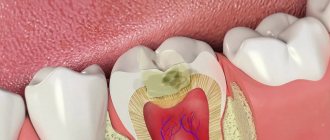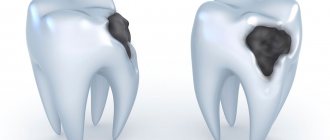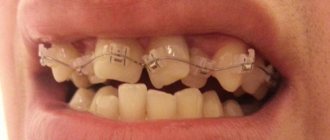A child’s first tooth erupts is a joyful event for parents. But what if there are no teeth at 6 or 8 months or even later? Is this really a problem or can it wait?
Milk teeth: by the age of 2–2.5 years, exactly 20 of them should grow
Sometimes the replacement of teeth with permanent ones is delayed, so sometimes an examination may be required to determine whether everything is in order.
Why may teeth not grow on time?
Individual characteristics
The average time for the appearance of the first baby tooth is 6 months, but teeth can begin to erupt at three months or a year, and both options are normal. If the child’s teeth do not appear, but there are no other complaints and the pediatrician does not notice any problems, then there is no need to worry until the child is a year or more old.
The same applies to the late beginning of the change of milk teeth to permanent ones. For some children, permanent incisors begin to appear already in the senior group of kindergarten, while others experience this moment at school. The normal period for the formation of a permanent bite is from 7 to 13 years.
Later than the average period, teeth may erupt in weakened, often ill children.
What to do?
Monitor other complaints, contact doctors if necessary, and if there are no complaints, then nothing. You cannot influence the rate at which teeth appear.
When do the first teeth appear?
At the time of birth, the baby's teeth are in a state of formation inside the jaw bones. The bone contains a complete set of primary teeth at different stages of growth. The front incisors are the earliest to form and begin to emerge through the gums at six months of age. With the correct development of the child, dental units continue to erupt in pairs, i.e. one on each side. A full set of twenty primary teeth should appear in the first three years of a child's life.
Partial edentia
Adentia is the congenital absence of tooth buds. Most often, the top two “twos” are missing. Moreover, there may be a lack of both milk and permanent teeth, or both.
Adentia is a congenital condition; it occurs due to a malfunction in the embryonic period during the formation of the main organs and systems.
It is very difficult to notice partial edentia of baby teeth: the teeth are small, they are all of a similar shape, and others take the place of the missing ones. Such adentia does not harm the chewing process in any way.
If permanent teeth are missing, this is already noticeable visually. In this case, malocclusion may develop, since the “threes” are pulled up to replace the missing “twos”, and the following teeth are also displaced.
Partial edentia - absence of upper incisors
Partial edentia - there are no upper incisors, but “threes” have taken their place
The exception is wisdom teeth, also known as “eights.” Their functions are not so important; in most people they remain impacted, and if they are lost, they are not replaced with prosthetics. Their absence does not affect the health and aesthetics of the smile.
What to do?
If there is a partial lack of permanent teeth, it is most often necessary to correct the bite and prepare a place for prosthetics. If you do not make dentures, but cover the empty space with neighboring teeth, then this will not be a complete solution to the problem - the dentition will be narrower than it should have been.
What determines the timing?
The timing of the formation of both temporary and permanent dental units in children can be compared with certain phenomena.
- Floor. In girls, all teeth, except the first upper chewing one, erupt earlier than in boys.
- Jaws. Teeth appear faster on the lower jaw than on the upper jaw.
- Position of teeth. Molars and premolars most often erupt with a delay.
- Bite. In primary dentition, delay occurs much less frequently than in permanent dentition.
- Population. Scientists have found that people living in different countries have different timing for the appearance of teeth. For example, among Europeans, delayed eruption is a fairly common occurrence.
- Climatic conditions. In warm climates, teeth erupt faster than in cold climates.
- Level of urbanization. City residents develop teeth faster than those in rural areas.
- Evolution. Recent generations are more likely to encounter anomalies in the eruption of wisdom teeth and canines in the upper jaw. Scientists explain this phenomenon with the evolution of humans as a species, and with the lack of space due to a decrease in the overall size of the jaw.
Completely edentulous
This is a rare phenomenon - the complete absence of tooth buds (deciduous or permanent). In this case, teeth cannot erupt because they are simply not in the jaw bone.
Complete edentia in the picture
In medicine, cases have been described when a patient had milk teeth, but permanent teeth were completely absent. The loss of baby teeth was timely, but permanent teeth did not appear in return. At this moment, the child’s parents paid attention to the problem, and the dentist made a diagnosis.
In addition to congenital, adentia can be acquired if the child has undergone severe treatment (chemotherapy) at an early age. Due to the toxic effects of drugs, tooth buds may be damaged.
What to do?
Edentia is clearly visible on a CT image. If such a diagnosis is made, the only option is complete prosthetics. Since the case is rare, the question of when to get dentures and in what way should be decided individually.
If you do not replace missing teeth with prosthetics, the chewing process cannot be complete. Even the lack of 2-3 teeth affects digestion. Bone tissue, if the jaws do not receive enough load when chewing, undergoes resorption (resorption), and this leads to weakening and loosening of the remaining teeth, increasing the risk of periodontal disease.
Therefore, if you have any complaints about your child’s teething being too slow, you should consult a doctor. In most cases, it turns out that there is no pathology, all teeth are fine and will grow a little later. But in rare cases, prosthetics may be required, which is better to know in advance. Then you can schedule treatment on time.
Other articles:
If a child does not want to be treated by an orthodontist...
When should your child see an orthodontist?
How to help your child not be afraid of dentists
Reasons for delay in teething
There can be many reasons for delays in teething.
- Hereditary factor. If parents cut teeth later than other children, then this symptom may also be observed in their children.
- Prematurity or low birth weight of the baby.
- Diseases of the expectant mother during pregnancy, injuries during childbirth, as well as illnesses of the child in the first few months after birth.
The factors listed above most influence the timing of eruption, as well as the quality of formation of dental units.
Other reasons include:
- violations in the child’s diet;
- lack of certain vitamins and minerals;
- hypothyroidism;
- rickets and its consequences.
It should also be taken into account that girls are ahead of boys in development, and, therefore, their teeth appear earlier.
Reasons why there may be more teeth than normal at 8 months
There is another problem - parents think there are too many teeth. That is, a child at 8 months has grown more than 8 teeth. Is this really a pathology, and should parents worry?
There is no need to panic. When the first teeth appear after 3 months, this is an indicator of the norm. This happens if the expectant mother constantly takes prenatal vitamins or drinks them while breastfeeding. This is also possible in bottle-fed children. This means that the child’s body has enough microelements and essential substances.
This is interesting: Enamel hypoplasia: causes, types and symptoms, methods of dental treatment in children and adults
It’s another matter when the first incisors appeared before 3 months of age. In this case, there is reason to suspect diseases of the endocrine system. You need to show your baby to a doctor and undergo an examination.
Teething symptoms
There is an opinion that the appearance of the first teeth is accompanied by the development of a whole complex of pathological processes (fever, the appearance of a rash, abnormal stool, vomiting, convulsions, etc.). In fact, the formation of a temporary bite is a natural process that is not characterized by the symptoms described above. Pathologies detected during the teething period are most often manifestations of infectious diseases or a consequence of changes in diet.
In particular, factors that can lead to the appearance of unpleasant symptoms include:
- introduction of artificial complementary foods;
- hypovitaminosis;
- acute viral infections;
- stomatitis;
- tonsillitis;
- runny nose;
- otitis;
- vaccination, etc.
The true symptoms of teething are:
- hyperemia and gradual swelling of the gums;
- the appearance of a small bluish hematoma on the gum tissue;
- slight bleeding from the gums;
- wet cough;
- mild itching caused by mechanical irritation of sensitive nerve fibers in the gum tissue;
- increased salivation;
- various somnological disorders;
- sharp deterioration in appetite;
- tearfulness, capriciousness.
How a dentist can help
If you are not ready to wait a year, seek help from a good pediatric dentist. The specialist will take an X-ray of the jaw to ensure the presence of tooth buds. If everything is fine, all you have to do is calmly wait for the process to begin - gum enlargement and increased salivation. Now it's time to help the baby:
- a ring stimulator will moderate itching, reduce discomfort and speed up teething;
- You can gently massage your child’s gums with a clean finger or a small spoon;
- stimulates tooth growth and fortified complementary foods - healthy juices and purees. While there are no teeth, solid complementary foods cannot be introduced.
How to save your front baby teeth
The main and main cause of damage to the upper anterior incisors in children at an early age is “bottle caries”. And today it is far from uncommon. Moreover, caries begins at a very early age (sometimes even in infancy) and develops not just quickly, but rapidly. Where does it come from? It's simple: caries develops as a result of night feeding with breast milk, artificial formula, compote or juice. Any sugar-containing liquids literally stick to the teeth, flowing from the side on which the baby sleeps and to the front upper teeth. And since saliva is not produced during sleep, sugar remains on the teeth and begins to destroy the enamel, which leads to caries. To the greatest extent (90% of cases) it affects the upper incisors and chewing teeth. And if the treatment of the latter does not cause any particular difficulties, then there are still many questions, disputes and disagreements regarding the front incisors.
Where does caries begin?
Caries begins with a white spot on the tooth, which most often goes unnoticed if the baby is not shown to the pediatric dentist in time. The “white spots” do not bother the baby himself. However, literally within a few months, carious cavities can become very deep, causing the child quite severe discomfort during meals and even at night.
What happens if you don’t treat your child’s teeth?
It’s simple, a fairly extensive chronic inflammatory process will arise, the frequent companions of which, in addition to dental problems themselves, are loose tonsils and other ENT diseases and even diseases of the gastrointestinal tract. In addition, bone tissue and the rudiments of permanent teeth suffer from chronic infection. And when the process reaches a “critical point,” the matter can end in fluxes and purulent fistulas, which are often accompanied by acute pain and high fever.
"Important" age
Children aged 1.5 to 4 years usually turn to pediatric dentists with similar problems. And often children come with almost destroyed front teeth. Namely, during this period, the front incisors are more important than ever, both from an aesthetic and functional point of view: they bear a fairly high load associated with biting food, especially hard food. In addition, without the front teeth, the bite (subsequently there may not be enough space in the jaw for permanent teeth) and speech (the tongue does not have support, and the child begins to lisp) are formed incorrectly. And of course, like adults, kids worry about the beauty of their smile. If black, dilapidated “stumps” stick out in the mouth instead of beautiful white teeth, children are embarrassed to smile and constantly cover their mouths with their hands.
And by the age of 5, the resorption of the roots of milk teeth will begin, and by 6-7 years, permanent teeth should erupt, the health of which directly depends on the condition of their milk predecessors. That is why you need to take care of the health of your upper incisors as early as possible.
What's the difficulty?
There are several reasons why treating frontal teeth in children is very difficult.
Firstly, only when treating incisors with deep damage to the enamel is the passage of canals mandatory. That is, everything is the same as in adults: you need to drill out the tooth, remove the nerve, take before and after pictures, go through the canal with a special material, and only after that can you put a filling. Therefore, treatment of only one front incisor takes 30-40 minutes!
Secondly, as we said, the main patients with caries of the front teeth are children from 1.5 to 3-4 years old (in 80% of cases these are children aged 2-3 years), so treatment is possible only under general anesthesia. For such a baby, finding contact “with someone else’s aunt” is still, to put it mildly, difficult, and the perseverance is still not enough to withstand such a long time in the dentist’s chair (if only the doctor needs an average of 30-40 minutes for one tooth, and such teeth 4 – so count for yourself).
By the way! It does not happen that one or two teeth are affected by caries, and the rest remain healthy - usually all 4 front incisors are always affected.
Background
It is because of all these difficulties that until recently there were not so many ways to “treat” the upper anterior incisors.
Depending on the degree of damage, the teeth were covered with silver. But since this approach gives absolutely no effect, the carious process soon destroyed them completely, and then the teeth had to be removed. The “side effects” of this method also include the fact that the “silver” makes the teeth turn black and, to put it mildly, does not look aesthetically pleasing, which only adds to the problems.
If the situation allowed, then sometimes it was possible to fill the canals in order to save space in the upper jaw for permanent teeth, and in the place of the former “milk jugs” there remained small “stumps” that were in no way capable of fulfilling their functional tasks, not to mention their appearance.
Another “popular” approach is to leave everything as is for as long as possible. We have already talked about fluxes and temperature. Actually, they became the consequences of such “treatment”. Result? Parents are simply forced to bring their child to the clinic for removal.
By the way! In the absence of teeth, the jaw narrows, and this subsequently negatively affects the bite: there is not enough space for permanent teeth!
True, sometimes with the help of all kinds of rinses and “traditional methods of treatment” at home, this acute process is removed, the baby rinses out the pus and continues to live with bad teeth and a chronic infection in the mouth, from which the bone tissue suffers.
By the way! Until 3 years of age, mineralization of the rudiments of the anterior permanent teeth occurs. And in fact, they are formed under conditions of constant inflammation and chronic infection. This means that the rudiments of permanent teeth do not develop normally: the teeth will be weak, and the enamel will be of uneven color and in some places immature.
What to do if teeth are removed after all
One of the modern solutions to this problem is a replacement plastic plate. However, although it holds the jaw well for permanent teeth, it is otherwise purely aesthetic in nature (outwardly it looks like real teeth), without bearing any chewing load.
The plate can only be installed at the age of 4.5-5 years. The fact is that it requires a conscious attitude on the part of the child. You need to take care of the plate, clean it, remember to take it off and put it on, you need to get used to it, like any other foreign object in the mouth. That is, the baby must understand why he is doing it, and, what is important, want to do it! And it is not always possible to “agree” with a child; it is especially problematic to do this with boys.
In addition, if teeth were removed at 2 years old, then at least until the age of 4 years the baby is forced to live without teeth, which is not physiological. Restoration of anterior teeth as an art of pediatric dentistry
Over the past few years, a number of clinics have begun to restore the anterior incisors. The roots of these teeth are treated, pins are placed, and the crown of the teeth is restored using filling materials. For aesthetic restoration, materials of different colors with corresponding names are used - “dentin”, “enamel”, “incisal edge”, so that the teeth can look as close as possible to their real teeth. Crowns: a modern and effective solution
Fortunately, today there is a solution to the problem of the upper incisors, such as crowns. Crowns are made of a hypoallergenic alloy and lined with zirconium oxide. This is a rigid and durable structure, which, like in adults, is attached to cement and holds the tooth well. In addition, from an aesthetic point of view, crowns look good. And children truly appreciate this: they begin to smile with pleasure without covering their mouth with their hand.
So, how does a crown “work” and help save teeth? The root of a tooth affected by caries is treated, the nerve is removed, and a canal is traversed. If the tooth tissue is preserved, then it is minimally filled; if not, then a pin is installed, and the tooth itself is restored (restored) with filling material. On top, slightly under the gum, crowns are placed, which play the role of protective “caps,” mechanically holding the tooth and helping to preserve the restoration until the teeth are replaced with permanent ones. It is by installing it under the gum that the crown helps protect the restored tooth, which consists of 90% filling material, when bitten off or injured.
Since by the time of treatment there is nothing left of your own tooth, crowns are selected “by eye”: impressions, like for adults, are never made. Based on the size of the roots and adjacent teeth, as well as the structure of the jaw, we can determine what size crowns are needed. However, we always install crowns that are slightly smaller than our real teeth to avoid the teeth not coming together when the child wakes up from anesthesia. Over the next few months, the installed crowns “sit” in the bite due to the plastic childhood periodontium and a number of other physiological features. If, for example, when fixing the crown, the crown was turned out, then when the baby comes for a consultation after 2-3 months, the teeth are in a row. Nature literally helps children. This simply cannot happen to an adult!
By the time the baby teeth are replaced by permanent ones, the roots of the “milk jugs” begin to dissolve. As a result, the crowns fall out along with the pin, and permanent teeth take their place.
Clear benefits
Of course, both of these methods allow you to preserve the front incisors until they are physiologically replaced. It is very important! But let's figure out how the baby feels...
Firstly, after treatment of the roots of the teeth and subsequent restoration, the child begins to eat normally and gains weight: after all, with severely damaged teeth, as we said, contact with food causes discomfort and sometimes even acute pain. Meat, apples, carrots appear in the toddler’s diet - that is, things that he simply could not bite or chew before. Secondly, since nothing bothers the baby (and at the stages of deep caries, children often experience pain at night), he sleeps better. Thirdly, the teeth look very aesthetically pleasing, and now the baby can smile from ear to ear without embarrassment. Tell me, is this not enough?
It's important to remember that...
...installing crowns takes less time than aesthetic restoration of teeth using filling materials. And this, in turn, allows you to reduce the time of anesthesia. In addition, the filling material gains color over time (stained by food and drinks), cracks appear on it, so it must be polished periodically. And lastly: crowns allow for 70% better preservation of teeth, protecting them from injury and mechanical damage during chewing. But the materials used for restoration are not strong enough and often break.
Nevertheless, the method of preserving the front teeth in each case is selected individually, depending on a number of indications and contraindications, the state of the oral cavity, etc. The main thing is that now it has become possible! We are convinced that if it is possible to save a child’s teeth for 2-3 years, ensuring normal chewing and jaw development, then this is a huge achievement and truly “aerobatics” for pediatric dentists.
What about the deadlines?
Some parents use a special formula to determine how many teeth a baby should have at nine months. It looks like this:
K=M – 4,
where K will be equal to the number of teeth, and M will be the number of months of the toddler’s life.
But even if teething begins only at one year, parents should not panic. This is also the norm.
Children's teeth may appear one at a time or in pairs. Moreover, in this way not only the first ones erupt, but also those following them. There are cases when a baby has as many as four teeth coming out at the same time. By the way, massive teething will affect the timing.
It is human nature to doubt. Especially for parents of little ones. It often happens that a child is 9 months old and has no teeth. Why? If at this age or even a year the baby does not have a single tooth, you should consult a doctor to make sure that the little one does not have rickets or hypothyroidism.
Typically, the first twenty teeth should appear before two and a half to three years of age. Each baby’s jaw should have four incisors, two canines (also called canines) and four molars. In an adult, it is considered normal to have twenty-eight or thirty-two teeth - on each jaw there are 4 incisors, two canines, four premolars and from four to six molars.
When baby teeth begin to emerge, there are initially no gaps between them. This is normal. A little later, when the child’s jaw grows, by the age of four the teeth begin to diverge and gaps form between them. This process is necessary to accommodate the molars because they are much larger than baby teeth. If such gaps do not appear, then subsequently the molars will not be able to fit in and will grow crookedly.
What to do to ensure that your child’s teeth develop normally
Before and during pregnancy:
- Maintain dental health.
- Eat well and varied.
- Eat more foods high in calcium.
- Do not smoke or drink alcohol.
- Walk in the fresh air more often to maintain a healthy level of hemoglobin in the blood.
- Treat in strict accordance with medical recommendations.
After childbirth:
- provide the child with a rich and balanced diet;
- monitor the baby’s hygiene;
- walk in the fresh air to harden the child’s body;
- prevent infection and diseases of internal organs;
- Consult a doctor in a timely manner in case of painful syndromes.
The period of active growth and weight gain continues
At nine months, your baby will still look like a baby—with a big head, chubby legs and arms, and an adorable belly. As he begins to move more and test his strength in standing and walking, the outline of the child's figure will begin to change.
According to Russian pediatricians, on average at nine months your baby will have:
- weight gain per month of 500 g, weight up to 8600-9000 g;
- height increase per month of 1.5 cm, height approximately 74 cm;
- head circumference - 44.5-45.5 cm;
- chest circumference - 46.5-47.5 cm.











